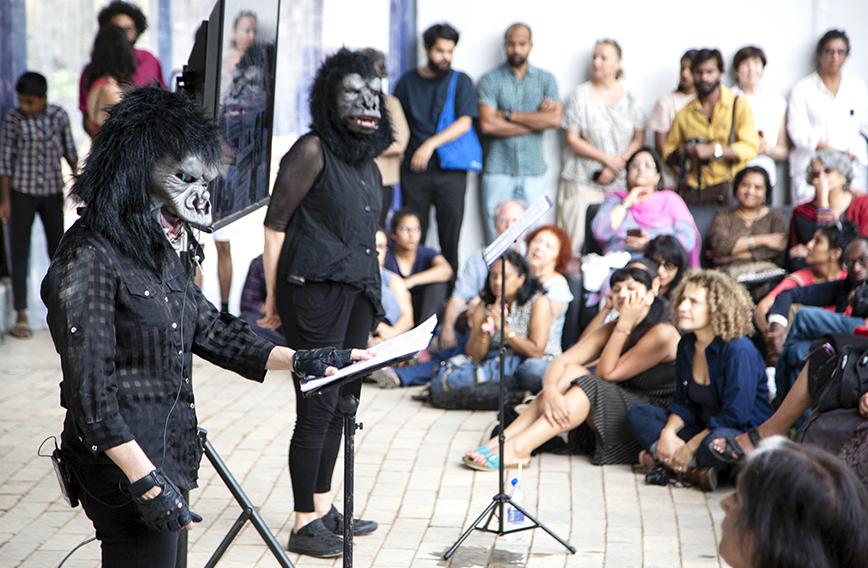
The Guerrilla Girls from New York
Biennale opens up to bring everyone on board in Kochi
Saibal Chatterjee, Kochi
An immersive sound art installation by 43-year-old Mumbai-based artist Shilpa Gupta titled “For, In Your Tongue I Cannot Hide” is dedicated to poets imprisoned, and even executed, for their writings in different countries and centuries. Lines penned by 100 such literary renegades are transmitted through speakers strung from the ceiling in a room. Under the microphones are metal stands that hold printouts of the poems of such rebels as Dareen Tatour, Liu Xia, Habib Jalib, Amanuel Asrat, Irina Ratushinskaya, Hadraawi and Mikayil Mushfig, to name only a few. Gupta’s purpose is obvious: bring back to life those sought to be silenced by totalitarian regimes.
Ninety-four artists from 30 nations are exhibiting their works in public spaces and heritage sites across Fort Kochi and Mattancherry in Kerala as part of the fourth edition of the Kochi-Muziris Biennale (KMB).
This sprawling 108-day art fiesta is unlike any of the previous three Biennale editions. A few of its principal goals are: Giving voice to the voiceless, documenting resistance against tyranny, lending depth and new meaning to an evolving gender discourse in the #MeToo era, seeking out unsung artists from the shadows and a better deal for women in the art world.
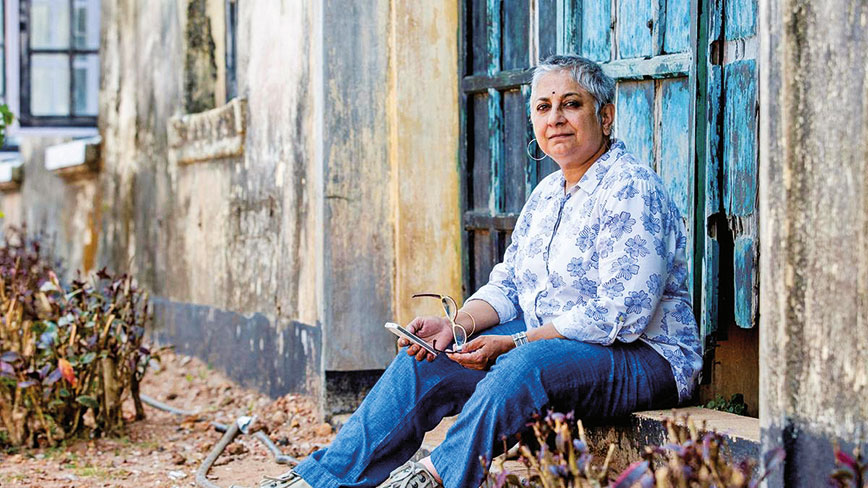 Anita Dube, curator of the 2018-2019 Kochi-Muziris Biennale
Anita Dube, curator of the 2018-2019 Kochi-Muziris Biennale
Conceived and curated by eminent 60-year-old artist Anita Dube, the first woman at the helm of the show, the event has seen a radical shift in emphasis. With its curatorial vision hinging on “Possibilities for a Non-Alienated Life”, India’s largest festival of its kind has brought voices barely heard and traditions rarely accommodated in the contemporary art world closer to the mainstream.
The Kochi-Muziris Biennale opened on December 12 and will continue till March 29.
Works by artists from the Arab world, the African continent and under-represented corners of India stand alongside installations by globally celebrated veterans such as Sue Williamson, William Kentridge, Bracha Ettinger, Martha Rosler and Julie Gough, besides a host of Indian luminaries.
 Gond artists Durgabai and Subhash Vyam's wall-based installation
Gond artists Durgabai and Subhash Vyam's wall-based installation
More than half the participating artists in KMB 2018 are women. That apart, Dalits, tribals, transgenders, people of colour, and artists from conflict zones, among others, occupy prime slots in the ongoing Biennale to embody Dube’s “desire for liberation and comradeship where the possibilities for a non-alienated life could spill into a politics of friendship”.
By drawing many artists who exist outside the rarefied realms of galleries, museums and auctions into KMB’s fold, the curator has sought to create a space “where pleasure and pedagogy could sit together and share a drink, and where we could dance and sing and celebrate a dream together”.
Artists from Kenya, Cameroon, Lebanon, Palestine, Pakistan and Bangladesh are here with works marked by singular styles. “Decentralised collaboration” is the leitmotif of this Biennale.
The festival has taken into its sweep a wide range of challenges facing the world today and is, therefore, focused on works of artists and photographers who address conflict, assaults on individual freedom, and the many manifestations of social injustice.
This is true of the entire expanse of the Biennale. Besides the exhibitions at 10 different venues, there is an array of ancillary programmes — talks, seminars, workshops, film screenings (the Artists’ Cinema segment is a favourite for many) and a medley of musical soirees.
 Durgabai and Subhash Vyam
Durgabai and Subhash Vyam
“I’ve conceived this like a musical score which is created by an array of instruments. But music relies on effects; art exhibitions hinge on ideas, images, fragments…. This Biennale brings together varied materialities, styles, traditions and media,” explained Dube before a walkthrough organised a day ahead of the Biennale opening.
The latest edition of the KMB is indeed like a complex 94-piece orchestra producing a diverse range of stimuli, an euphony of the finest timbre. The works on show are cautionary, but they also project the tenacity of the artist in the face of the growing threats to a world in the grip of rightwing politics.
“It is historic,” says Dube, “that this Biennale is taking place at this point of history in my home country.” Her allusion is, of course, to the distortions being injected into our notion of nationhood, leading to a souring of the dreams that once gave a newly independent country a positive impetus.
Subaltern imprint
The “follies of history” parade across 63-year-old South African artist William Kentridge’s dirge, More Sweetly Play the Dance, an eight-screen, 12-minute video installation spanning from the floor to the ceiling. The work, supported by a 10-track audio system, depicts a dancing column of animated drawings and videos of dancers enacting various forms of an elaborate danse macabre. It shows a procession of sickly figures supported by intravenous drips, priests marching with funeral flowers and people dragging sacks and dead bodies, led by a brass band, with world maps, text from Kentridge’s notebooks and Chinese characters constituting the backdrop. The installation alludes to real events without being specific by riding into a dark metaphorical abyss of death, disease and destruction.
 A splash of graffiti on a wall
A splash of graffiti on a wall
Another South African artist, 78-year-old Sue Williamson, travels centuries back in time in her installation, “One Hundred and Nineteen Deeds of Sale”, to focus on a horrific part of Kochi’s history. She throws light on the young men and women from Kochi who were enslaved by Dutch colonisers and shipped to Cape Town to work on projects to build the New World. On a clothesline in the sea-facing backyard of Aspinwall, she has hung 119 pieces of cotton cloth with names of the slaves written on them — a memorial to the forgotten victims of history.
One of the more exciting parts of the biannual art event are the provocative posters put up by the Guerrilla Girls, a feminist collective founded in New York in the mid-1980s to fight sexism and racism in the art world. These women hide behind gorilla masks and assume the names of dead female artists. The two Guerrilla Girls who attended at KMB 2018 called themselves Frida (Kahlo) and Kathe (Kollwitz). Their posters, plastered on the walls inside and outside the compound of Aspinwall House, drew attention to all that is wrong with museums and galleries as a result of the dominance of powerful and wealthy white men.
One Guerrilla Girls poster at the entrance to Aspinwall read: “Don’t let museums reduce art to the small number of artists who have won a popularity contest among big-time dealers, curators and collectors. If museums don’t show art as diverse as the cultures they claim to represent, tell them they’re not showing the history of art, they are just preserving the history of wealth and power.” How perfectly well that sums up what Dube is trying to achieve with this Biennale — a sharp break from established practice by opening out the festival space to artists on the fringes!
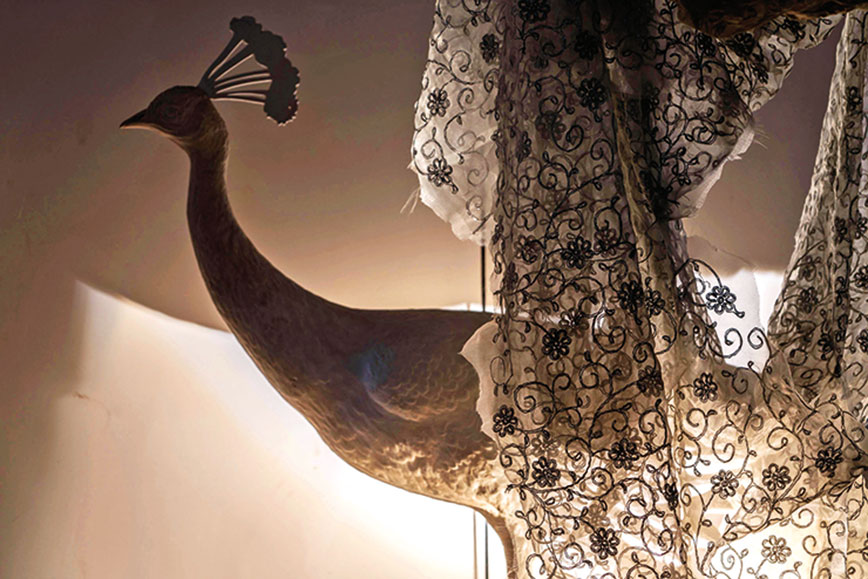
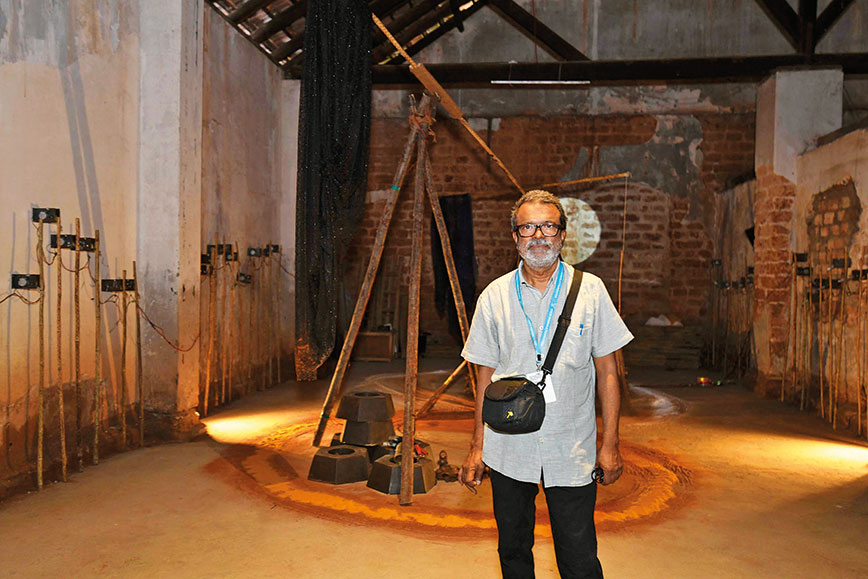 B.V. Suresh and a peacock from his installation, ‘Canes of Wrath’
B.V. Suresh and a peacock from his installation, ‘Canes of Wrath’
If not as dramatic as the in-your-face defiance of the Guerrilla Girls, the Sister Library that Darjeeling’s Mumbai-based art activist, Aqui Thami, has brought to Fort Kochi is equally telling. It is a travelling library that has an evolving catalogue of books by women writers, an effort aimed at countering the gender imbalance in the availability of reading material in mainstream spaces. Thami’s personal collection forms the core of Sister Library, but readers keep adding to it by contributing books and periodicals by and about women.
Rebel and resist
A large mural put up by Prabhakar Pachpute, an artist from the industrial town of Chandrapur in Maharashtra, conveys the plight of villagers resisting the profit-driven plans of mining corporations. It calls for action to save farmers from multinational companies and oppressive governments.
The work, Resilient Bodies in the Era of Resistance, consists of large plywood cutouts on which 32-year-old Pachpute has used charcoal and acrylic colour to paint the continuing struggle of his village to keep powerful foes at bay. He belongs to a family that works in coal mines.
Paris-based French-Guyanese artist, healer and yoga teacher Tabita Rezaire has come up with a work, “Sorry for Real Sorrow”, which seems to capture the history of violence against and exploitation of African and other indigenous lands, bodies and knowledge bases. Her work, a series of lightboxes with holographic apologies issued on behalf of the Western world, points to the replacement of one form of colonial power relations with another.
“We are heading towards internet colonisation,” says the 30-year-old artist. During her research for this work, Rezaire stumbled upon the fact that today’s undersea fibre cables have been laid along the old shipping routes that the imperialists used.
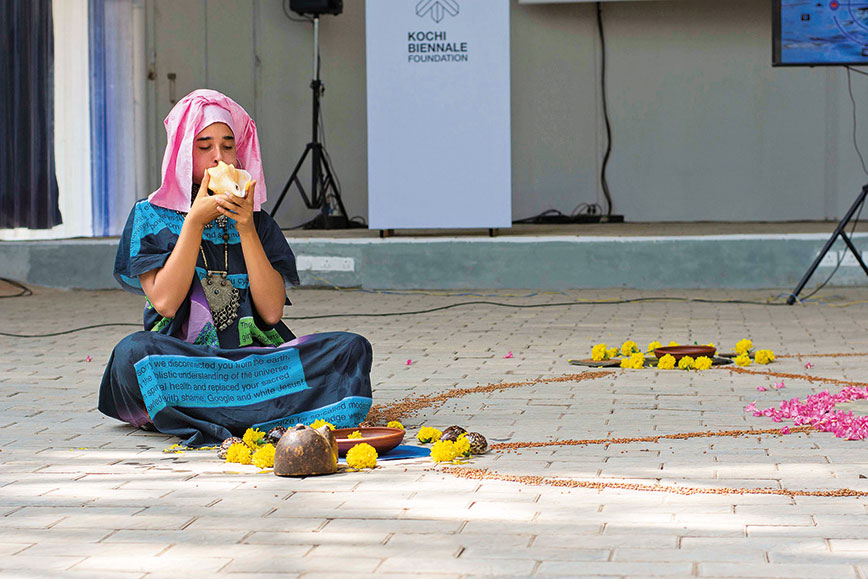 Tabita Rezaire performing
Tabita Rezaire performing
At the other end of the Biennale spectrum is the husband-wife duo of Gond artists, Subhash and Durgabai Vyam, who have mounted ply board artworks on the walls of a room in Aspinwall. These pieces of art are inspired by the central Indian tribe’s traditional stories. The couple also conducted a well-attended workshop designed to introduce local children to the intricacies of Gond art.
We live in dark times and nowhere is that revealed more starkly than in the dimly-lit coir godown of Aspinwall House, one of the main venues of the Biennale. One of the artists exhibiting here is Bengaluru-born B.V. Suresh, 58. He captures the state of the nation in a work that uses cane sticks to strike out against the rising tide of hate-mongering, mob violence and suppression of dissent. Battery-powered cane sticks constantly crash against the floor while an “angry Hanuman” video plays on loop and broomsticks rotate incessantly.
Suresh’s work, titled “Canes of Wrath”, also features a peacock that has lost its colours — a metaphor for the undermining of India’s pluralism — and burnt bread loaves (a reference to the razing of Best Bakery during the Gujarat riots of 2002). “The peacock, India’s national bird, is so colourful. But here it is an albino,” says Suresh, who now teaches in the University of Hyderabad and is also part of KMB’s Students Biennale as an educator. “This is to show that our country is losing its varied hues as our diversity comes under constant attack.”
“We want to open up as many possibilities as we can,” says Dube. “Mono-culture is killing us. So I’ve mixed up the little traditions with the larger ones. I’m trying to break the hierarchy.” Towards that end, she has included a series of images by photographer Vicky Roy, who grew up on a railway platform and in a shelter home; the works of Bapi Das, a former auto-rickshaw driver in Kolkata who does intricate embroidery on cloth; and a complex installation by Vinu V.V., a Dalit artist from Kerala who is acutely aware of social injustice and is influenced by the artisanal and ritualistic practices of his community.
Vinu’s installation at KMB 2018 centres on sculptures made from the wood of a tree that bears poisonous fruit. Hundreds of figurines are nailed to tree trunks, a gender-reversed rendition of a practice in which possessed women drive nails into the walls of a temple in order to be cured of their affliction. Enhancing the impact of the work is Vinu’s use of poetry and other literary inputs to underline a narrative in which the dispossessed and the ostracised are the protagonists.
Bapi Das, 39, stopped driving an auto-rickshaw in 2017. But he now works as a gardener in a Hindu burial ground to make ends meet. He devotes all the time he has after his duty hours, which span from 6 am to 2 pm, to his difficult art. “Some of my pieces take up to four hours to finish. One of the larger works took me four years,” he says. “It puts severe strain on the eyes, so I have to keep taking breaks.”
The self-taught Das rues the fact that despite his growing visibility, he still isn’t taken seriously by the art world, barring a few well-known artists who mentor and patronise him. The Purulia-born Vicky Roy, 31, is formally trained in photography, and has found acceptance easier to come by. “I did a four-year course and also spent six months in New York City honing my skills,” he says.
Artists for Kerala
Memories of the floods that ravaged Kerala last year are still fresh. Not only have several artists come up with exhibits as reminders of the devastation, the Kochi Biennale Foundation (KBF) has taken several initiatives to contribute to the relief efforts. For one, all the raw materials used at the Biennale will be repurposed to build houses for victims of the floods.
At least a dozen homes of 600 square feet each will be built with the remains of the Pavilion in Cabral Yard. The Pavilion has been envisioned by Dube as the festival’s central hub for open dialogue and performances. “The exhibition mode is no longer enough,” she says. “We also need a space for conversations.” The Pavilion is a platform for film shows, lectures and pop-up programmes. “Anybody can enter the space and say I want to share something,” says Dube.
Also part of the Biennale’s plans, an art auction — Art Rises for Kerala (ARK) — was held on January 18 in conjunction with Mumbai-based auction house SaffronArt. It was preceded by a preview exhibition held at Bastion Bungalow, a heritage property by the sea, from January 5 to 17. Artists featured in the auction included Anish Kapoor, A. Ramachandran, Gulam Mohammed Sheikh, Dayanita Singh, Anju and Atul Dodiya, Madhvi and Manu Parekh, Shilpa Gupta and Mithu Sen, besides Amrita Sher-Gil.
Bose Krishnamachari, artist and KBF president, attributed the success of the auction, the first of its kind in Kerala, to the strong bonds the Biennale has developed with the larger community of artists. “Artists have shown great solidarity with our core values. We are overwhelmed by the support we’ve got from the art community in this time of need,” he said. The proceeds from the auction will go into the Chief Minister’s Distress Relief Fund.
 Aryakrishnan's interactive and live archive in memory of slain transgender activist Maria
Aryakrishnan's interactive and live archive in memory of slain transgender activist Maria
Individual exhibiting artists, too, have recorded their sense of alarm at the damage wreaked by the natural calamity that hit Kerala in August and also extended their support to the flood-affected. Bangladeshi artist Marzia Farhana has put up a multimedia installation, “Ecocide and the Rise of Free Fall”, which captures the trail of destruction. For this work that denotes lives and homes turned upside down, Farhana used material collected from flood-ravaged parts of Kerala.
Members of Kerala’s Oorali music and art collective, which is officially participating in KMB 2018, will travel in their bus along the state’s coastline, staging 10 shows for fishermen at different locations. The bus itself is converted into a stage at every stop. This initiative is in recognition of the key role fishermen played in the rescue and relief operations. Formed in 2010, Oorali has performed around India and the world. “Every performance is an opportunity for Oorali to remind each other, all of us, that we are a commune of humans, beyond whatever we imagine,” says the commune’s mission statement.
Temsuyanger Longkumer, a London-based artist from Nagaland, has three works in the Biennale, one of which is Kerala-centric and represents hope in the face of adversity. His Catch a Rainbow II, at Pepper House, not far from Aspinwall, creates a rainbow that is visible night and day. This work, says Longkumer, is also a reaction to the recent Supreme Court ruling against the IPC’s Section 377 that criminalised homosexuality.
Kochi-based artist Aryakrishnan, 37, who worked here as a young curator on the first two editions of the Students’ Biennale, is participating this year with Sweet Maria, his tribute to his friend and transgender activist who was killed in 2012. His project for the Biennale is an archive that recounts the work of the late activist. “It is tough to slot Maria in just one form of art,” says Aryakrishnan, an Ambedkar University alumnus who now lives and works in Delhi. “So this work is a monument that uses different forms of engagement to recreate Maria’s aesthetics and politics.”
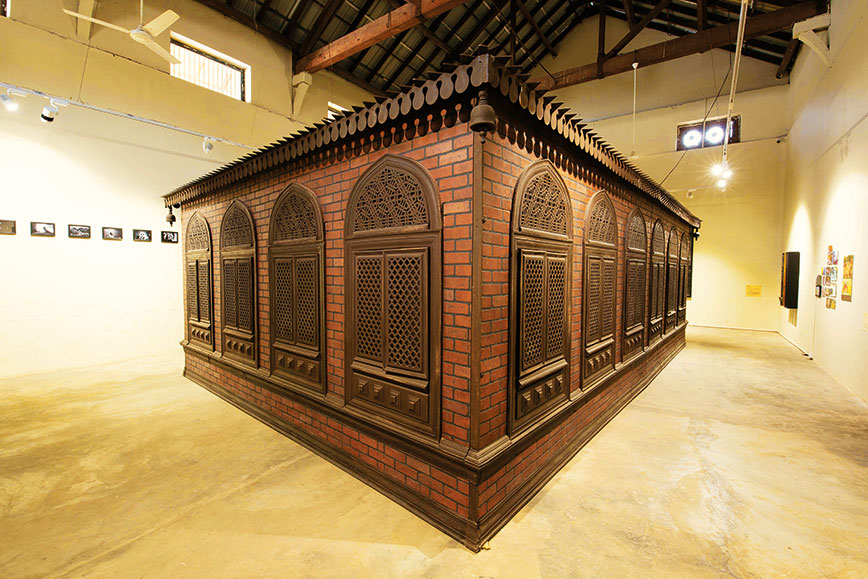 Veer Munshi’s,‘Relics from a Lost Paradise.’
Veer Munshi’s,‘Relics from a Lost Paradise.’
Srinagar special
The personal and the political merge seamlessly in the works of the Kashmiri artists who are here with the Srinagar Biennale, one of the infra-projects at KMB 2018. This segment, curated by Veer Munshi, features 14 Hindu and Muslim artists from the Valley trying to explore the many dimensions of the conflict that began in the late 1980s.
Put up at the TKM Warehouse in Mattancherry, the central element in the project is a structure that resembles a Sufi dargah with a number of coffins, some open, some closed, with papier-mache bones and skulls. Munshi’s work, titled “Relics from the Lost Paradise”, draws from elements of Kashmiri architecture reinforced by secular values. “A Sufi shrine is considered a place of worship open to all,” says the 63-year-old Delhi-based artist.
As part of the project, the collective did a 12-hour performance featuring Saquib Bhat and Hina Aarif. The two artists frisked people visiting the exhibition area to indicate how constant surveillance has become the norm in Kashmir. The duo confiscated personal belongings, restricted people’s entry and asked for identity proof without speaking or providing any justification. “Many felt offended,” says Bhat. Adds Aarif: “Others were confused. They did not know why we were frisking them.”
A state of mind is transported from one part of India to another more than 3,500 km away. Art knows no boundaries.
Comments
-

Abeer - Feb. 24, 2019, 6:39 p.m.
A very illustrative, representative coverage of the Biennale and it read even better after seeing the Biennale.
-

Prema Sagar - Feb. 4, 2019, 12:13 p.m.
AWESOME!



